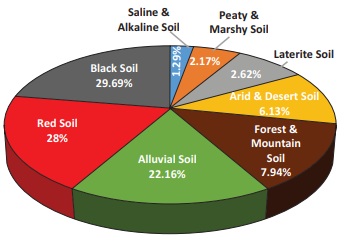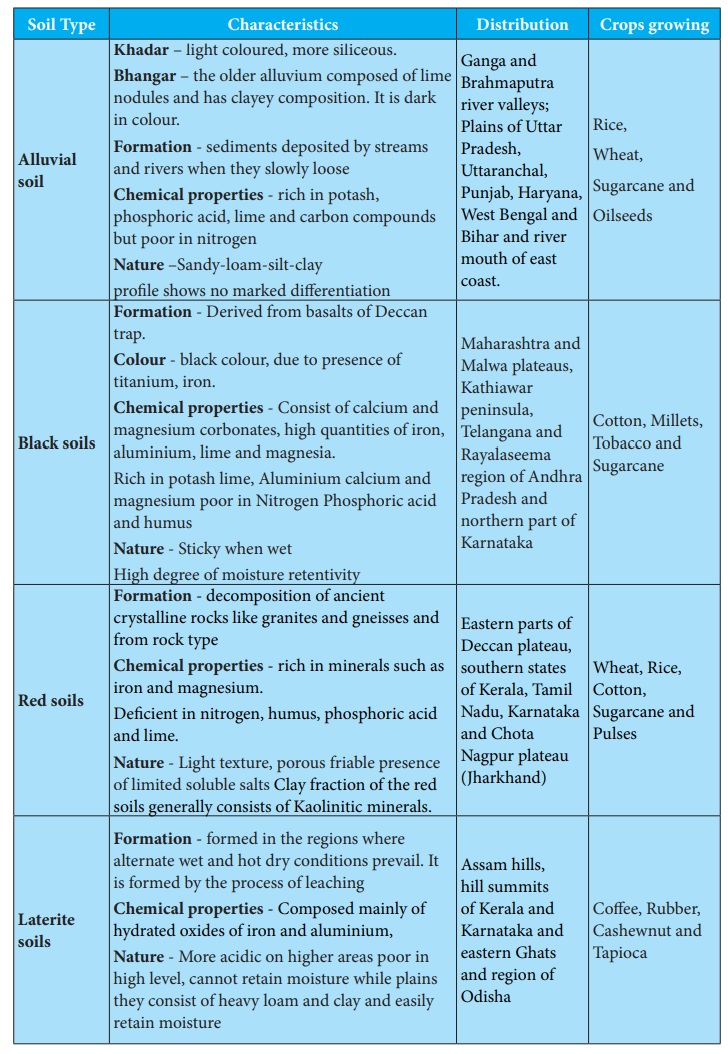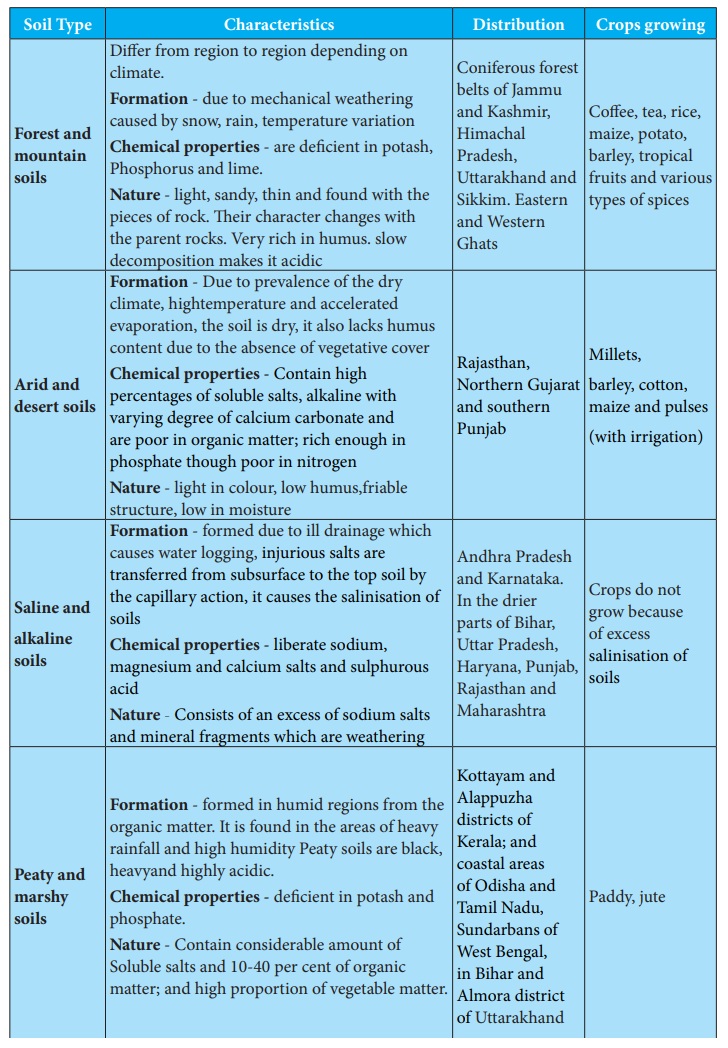Chapter: 10th Social Science : Geography : Chapter 3 : India - Agriculture
Types and Characteristics of Soils in India
Soils
Soil is
the uppermost layer of the land surface, usually composed of minerals, organic
matter, living organisms, air and water. Grains in the soil are of three
categories namely, clay, silt, and sand. Soils are generally formed by the
weathering of rocks under different conditions. Some soils are formed by the
deposition of agents of denudation. Soils can vary greatly from one region to
the other.
Types of Soils
The Indian Council of Agriculture
Research (ICAR) set up in 1953 divides the soils of India into the following
eight major groups. They are
1. Alluvial
soil
2. Black
soils
3. Red
soils
4. Laterite
soils
5. Forest
and mountain soils
6. Arid
and desert soils
7. Saline
and alkaline soils
8. Peaty and marshy soils


Characteristics
Alluvial soil:
Khadar – light
coloured, more siliceous.
Bhangar – the
older alluvium composed of lime nodules and has clayey composition. It is dark in
colour.
Formation
-
sediments deposited by streams and rivers when they slowly loose
Chemical
properties - rich in potash, phosphoric acid, lime and carbon
compounds but poor in nitrogen
Nature –Sandy-loam-silt-clay
profile shows no marked differentiation
Black soils:
Formation
- Derived
from basalts of Deccan trap.
Colour - black
colour, due to presence of titanium, iron.
Chemical
properties - Consist of calcium and magnesium corbonates, high
quantities of iron, aluminium, lime and magnesia.
Rich in potash lime, Aluminium calcium and
magnesium poor in Nitrogen Phosphoric acid and humus
Nature - Sticky
when wet High degree of moisture retentivity
Red soils:
Formation
-
decomposition of ancient crystalline rocks like granites and gneisses and from
rock type
Chemical
properties - rich in minerals such as iron and magnesium.
Deficient in nitrogen, humus, phosphoric acid and
lime.
Nature - Light
texture, porous friable presence of limited soluble salts Clay fraction of the
red soils generally consists of Kaolinitic minerals.
Laterite soils:
Formation
- formed
in the regions where alternate wet and hot dry conditions prevail. It is formed
by the process of leaching
Chemical
properties - Composed mainly of hydrated oxides of iron and
aluminium,
Nature - More
acidic on higher areas poor in high level, cannot retain moisture while plains
they consist of heavy loam and clay and easily retain moisture
Forest and mountain soils
Differ from region to region depending on climate.
Formation
- due to
mechanical weathering caused by snow, rain, temperature variation
Chemical
properties - are deficient in potash, Phosphorus and lime.
Nature - light,
sandy, thin and found with the pieces of rock. Their character changes with the
parent rocks. Very rich in humus. slow decomposition makes it acidic
Arid and desert soils
Formation
- Due to
prevalence of the dry climate, hightemperature and accelerated evaporation, the
soil is dry, it also lacks humus content due to the absence of vegetative cover
Chemical
properties - Contain high percentages of soluble salts,
alkaline with varying degree of calcium carbonate and are poor in organic
matter; rich enough in phosphate though poor in nitrogen
Nature - light in
colour, low humus,friable structure, low in moisture
Saline and alkaline soils
Formation
- formed
due to ill drainage which causes water logging, injurious salts are transferred
from subsurface to the top soil by the capillary action, it causes the
salinisation of soils
Chemical
properties - liberate sodium, magnesium and calcium salts and
sulphurous acid
Nature - Consists
of an excess of sodium salts and mineral fragments which are weathering
Peaty and marshy soils
Formation
- formed in
humid regions from the organic matter. It is found in the areas of heavy
rainfall and high humidity Peaty soils are black, heavyand highly acidic.
Chemical
properties - deficient in potash and phosphate.
Nature - Contain
considerable amount of Soluble salts and 10-40 per cent of organic matter; and
high proportion of vegetable matter.


Soil degradation: Soil degradation is an acute problem in India. According to a
2015 report of the Indian institute
of remote sensing (IIRS). The estimated the amount of soil .erosion that
occurred in India was 147 million hectares.
The main problems of the Indian soils are i) soil erosion (sheet
erosion, Rill erosion, Gully erosion, Ravine and Badland) ii) Degradation of
Soil, iii) Water-logging, iv) Saline and Alkaline, and v) Salt Flats, types of
soils are different erosion.
Methods of
Conservation and Management of Soil
1. Afforestation
2. Constructing Dams and Barrages
3. Prevention of Overgrazing
4. Improved methods of Agricultural
practices
Contour method, Rotation of crops, Contour bunding, Strip cropping, Planting of shelter belts, Adopting the techniques of sustainable agriculture are different conservation methods for better soil management.

Related Topics